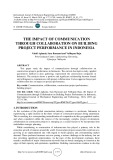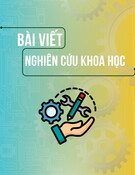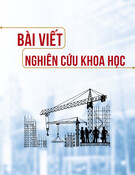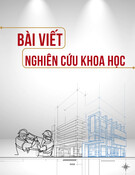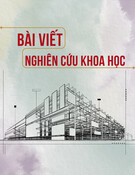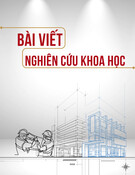
http://www.iaeme.com/IJMET/index.asp 1773 editor@iaeme.com
International Journal of Mechanical Engineering and Technology (IJMET)
Volume 10, Issue 03, March 2019, pp. 1773-1780. Article ID: IJMET_10_03_179
Available online at http://www.iaeme.com/ijmet/issues.asp?JType=IJMET&VType=10&IType=3
ISSN Print: 0976-6340 and ISSN Online: 0976-6359
© IAEME Publication Scopus Indexed
THE IMPACT OF COMMUNICATION
THROUGH COLLABORATION ON BUILDING
PROJECT PERFORMANCE IN INDONESIA
Vahid Aghania, Sara Ramzani and Valliapan Raju
Post Graduate Centre, Limkokwing University,
Cyberjaya. Malaysia.
ABSTRACT
This paper study the impact of communication through collaboration on
construction projects performance in Indonesia. The current descriptive study, applied
quantitative method in data gathering, represented the construction companies in
Indonesia. The analysis shows a positive and significant relationship between formal
and willingness to communicate with project collaboration. It also supports that project
collaboration has an impact on project performance.
Key words: Communication, collaboration, construction project performance,
building project
Cite this Article Vahid Aghania, Sara Ramzani and Valliapan Raju, the Impact of
Communication through Collaboration on Building Project Performance in Indonesia,
International Journal of Mechanical Engineering and Technology, 10(3), 2019, pp.
1773-1780.
http://www.iaeme.com/IJMET/issues.asp?JType=IJMET&VType=10&IType=3
1. INTRODUCTION
As the evolution of the global construction industry continues to accelerate, Indonesia is
experiencing a rapid increase in the sheer volume of construction projects being undertaken.
This is resulting in a corresponding intensification of competition in this geographical market,
and when considered within the context of the increasingly complex project environment,
collaboration in construction projects is emerging as a crucial feature to be incorporated into
stakeholder strategic planning.
While contributing to construction of infrastructure has played a primary role in the
economic growth of nations around the world. Construction projects around the world are now
growing at an unprecedented rate with regard to build capacity and corresponding market
demand. These profound increases are now posing a serious challenge to the industry but are
also providing significant opportunities. As the pace of this development continues, there
remain a multitude of major construction networks that are barely managing to function at the
edges of their capacity and operations capabilities. Building constructions continue to develop





